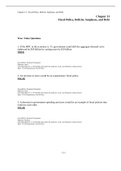Exam (elaborations)
Chapter 13 Fiscal Policy, Deficits, Surpluses, and Debt QUESTION AND ANSWERS|ALL YOU NEED DURING REVISION
- Course
- CECN 204
- Institution
- Ryerson University (Ru )
Chapter 13 - Fiscal Policy, Deficits, Surpluses, and Debt Chapter 13 Fiscal Policy, Deficits, Surpluses, and Debt True / False Questions 1. If the MPC in the economy is .75, government could shift the aggregate demand curve rightward by $30 billion by cutting taxes by $10 billion. TRUE Acces...
[Show more]



